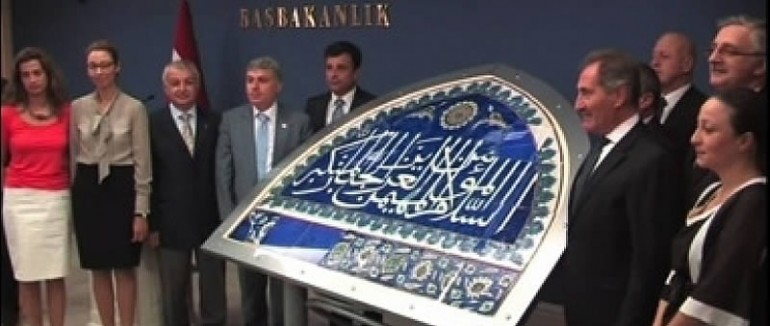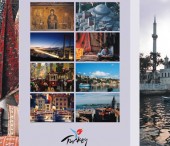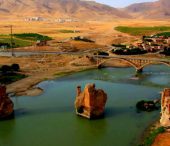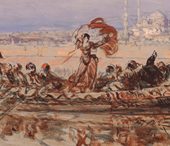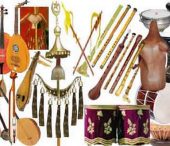In the last 10 years, Ministry of Culture and Tourism included 4136 historical artifacts - smuggled out of the country by various ways - back in our national wealth. Lastly, the Winged Seahorse Brooch, one of the most important pieces of Lydian Hoard, was delivered to Turkish officials by German authorities. The good news was given by Minister of Culture and Tourism Ömer Çelik, who is in Berlin.
The Winged Seahorse Brooch, which is the most important piece of Lydian Hoard and which was stolen from Uşak Archeology Museum in 2005 by switching with a fake, was delivered to Osman Süslü, General Director of Cultural Properties and Museums of Ministry of Culture and Tourism.
Minister of Culture and Tourism Ömer Çelik, who is at Germany´s capital Berlin, stated that the most important artifact smuggled from Turkey is back to Anatolian soil, and said "I welcome the Winged Seahorse Brooch to where it belongs, to Anatolia". Minister Çelik emphasized that such attempts were made on the course of Prime Minister Recep Tayyip Erdoğan´s instructions and in the frame of the government´s vision, and added "This is an artifact from Lydian Hoard, dating back to 6th century B.C. The Winged Seahorse Brooch is one of the most valuable artifacts among these, and we had been after it for a long time. Interpol was looking for it all over the world. When they understood that they could not sell this, it was delivered to Hagen Prosecutor´s Office. Our Ministry learned about this, and as the result of examination, it was immediately found out that this is the artifact switched with a fake at the museum in Uşak".
Total 363 artifacts belonging to Lydian Hoard, from the era of the Lydian King Croesus who reigned between 560-546 B.C., were found at Tekin Village of Uşak between 1965-68. The Winged Seahorse Brooch, stolen from Uşak Museum in 2005 after being switched with a fake, was seized in Germany as the result of field narrowing activities of Interpol and Smuggled Artifacts Branch Directorate of Ministry of Culture and Tourism. This jewelry, worth millions of liras, was kept in the safe of Central Bank by German authorities.
4136 Artifacts in 10 Years
With the return of the Winged Seahorse Brooch, the number of the artifacts taken back in the last 10 years reached 4136. These cultural properties, brought back from everywhere on the world after considerable efforts, are invaluable because that they reflect the social, cultural and artistic characteristics of the era they belong, and the scientific data they provide. These artifacts, including the 3300 years old Boğazköy Sphinx, the upper part of the Heracles sculpture from Ancient Greek and the ceramic tiles stolen from Bursa Sinanpaşa Mosque, on which verses from the Quran are written, are being displayed at museums they belong all over Turkey.
Until today, 1865 artifacts were recovered from Serbia, 1241 were recovered from Germany, 397 were recovered from Switzerland, 320 were recovered from Austria, 133 were recovered from Croatia, 56 were recovered from the UK, 40 were recovered from the USA, 23 were recovered from UAE, 23 were recovered from Australia, 20 were recovered from Bulgaria and 18 were recovered from France. 765 of total 4136 artifacts were recovered between 2002-2007. 1183 artifacts in 2008, 151 artifacts in 2009, 44 artifacts in 2010, 1885 artifacts in 2011, 84 artifacts in 2012 and 24 artifacts in this year were included back in our national wealth.
How are the Artifacts Taken Back?
Beginning especially as of the last years of Ottoman Empire, many artifacts were smuggled from the country after unauthorized excavations and researches carried out in Turkey, and they were sold to Museums and collections in Europe and America. Despite all the precautions and efforts in this field, smuggling of cultural properties still continues today with different ways.
In the case that an artifact belonging to any museum, ruins, or collection is stolen, the necessary announcements are made firstly by sending the photographed inventory information of the artifact to General Directorate of Foundations, Security, Gendarme, Ministry of Foreign Affairs, Ministry of Customs and Trade, Ministry of Justice and all Governor´s Offices. In addition, the stolen artifact is included in Interpol´s Stolen Works of Art Database, which 189 countries are members of. The Ministry, in close cooperation with the Interpol, initiates the necessary political and legal actions as soon as the artifact is detected in any country.
The bureaucratic process for the return of the stolen artifacts is relatively easier, since an inventory record is present. The return process of the artifacts, which were found during unauthorized excavations and therefore did not have an inventory record, is rather problematical. For the return of these artifacts, diplomatic attempts are made in the frame of mutual cooperation and good will. Finally, when the diplomatic attempts are fruitless, a lawsuit is opened for the return of the artifacts.
On the other hand, Turkey reinforces the cooperation by signing bilateral agreements with many countries in order to prevent the smuggling of cultural properties. The last one of these agreements was the "bilateral cooperation agreement for preventing the illegal import, export and transfer of the possession of cultural properties", which was made with Bulgaria on August 28, 2012. Furthermore, Turkey plays an active role in UNESCO´s "Intergovernmental Committee for Promoting the Return of Cultural Property to its Countries of Origin or its Restitution in case of Illicit Appropriation", which she is a member of.
Boğazköy Sphinx
The Sphinx, dated back to 1300 B.C., to Hittite Empire Era, is approximately 3300 years old. This artifact made of limestone is 2.5 meters tall, 1.75 meters wide, and weighs 1700 kilos.
During the excavations at Boğazköy, which were carried out between 1906-1912 under the administration of Ottoman Imperial Museum and with the participation of German committee members, around 10,400 tablets and two sphinxes were found.
As the result of the agreement made, the tablets and sphinxes were taken to Berlin by German excavation team - on condition of being returned - for cleaning, repair and publication studies. A part of the artifacts were returned, but Boğazköy Sphinx remained in Germany. Until 1938, the negotiations for the return of the artifact continued. However, the relationships were interrupted as the World War II began, and Berlin Museums remained in East Germany after the war. Turkey officially recognized East Germany in 1973, and the negotiations for the return of the sphinx restarted in 1974.
After years of contacts, an agreement was reached as the result of the meetings in Ankara and Berlin in 2011, and the artifact was returned in July 2011. The Sphinx is in display at Boğazköy Museum, together with its pair.
Upper Half of Heracles Sculpture
The lower part of Heracles Sculpture was found at Perga Ruins in 1980. In 1990, it was found out that the upper part of sculpture is at Boston Museum of Fine Arts. As the result of contacts continued for years, a memorandum of understanding was signed in 2011, and the sculpture was taken over.
The sculpture was brought to Turkey on September 25, 2011 with the airplane carrying Prime Minister Erdoğan and the official delegation, and it was delivered to Antalya Museum Directorate.
Sinanpaşa Mosque Ceramic Tiles
34 pieces of ceramic tiles, which were used as window decoration and on which a part of Verse 23 of Al-Hashr Surah from Quran was written, were stolen from Bursa Sinanpaşa Mosque in 2002. The tiles were found in England, and after intense efforts, they were returned to Turkey in August 2012 and were put to display at Ankara Ethnography Museum after restoration.
The Religious Affairs Administration gives the meaning of Verse 23 of Al-Hashr Surah as below:
"He is Allah , other than whom there is no deity. He is the Sovereign, the Pure, the Perfection, the Bestower of Faith, the Overseer, the Exalted in Might, the Compeller, the Superior. Exalted is Allah above whatever they associate with Him."
Sources: http://www.kdk.gov.tr/

